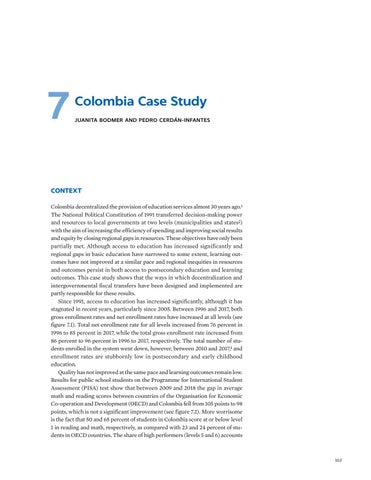7
Colombia Case Study JUANITA BODMER AND PEDRO CERDÁN-INFANTES
CONTEXT Colombia decentralized the provision of education services almost 30 years ago.1 The National Political Constitution of 1991 transferred decision-making power and resources to local governments at two levels (municipalities and states2) with the aim of increasing the efficiency of spending and improving social results and equity by closing regional gaps in resources. These objectives have only been partially met. Although access to education has increased significantly and regional gaps in basic education have narrowed to some extent, learning outcomes have not improved at a similar pace and regional inequities in resources and outcomes persist in both access to postsecondary education and learning outcomes. This case study shows that the ways in which decentralization and intergovernmental fiscal transfers have been designed and implemented are partly responsible for these results. Since 1991, access to education has increased significantly, although it has stagnated in recent years, particularly since 2005. Between 1996 and 2017, both gross enrollment rates and net enrollment rates have increased at all levels (see figure 7.1). Total net enrollment rate for all levels increased from 76 percent in 1996 to 85 percent in 2017, while the total gross enrollment rate increased from 86 percent to 96 percent in 1996 to 2017, respectively. The total number of students enrolled in the system went down, however, between 2010 and 2017,3 and enrollment rates are stubbornly low in postsecondary and early childhood education. Quality has not improved at the same pace and learning outcomes remain low. Results for public school students on the Programme for International Student Assessment (PISA) test show that between 2009 and 2018 the gap in average math and reading scores between countries of the Organisation for Economic Co-operation and Development (OECD) and Colombia fell from 105 points to 98 points, which is not a significant improvement (see figure 7.2). More worrisome is the fact that 50 and 65 percent of students in Colombia score at or below level 1 in reading and math, respectively, as compared with 23 and 24 percent of students in OECD countries. The share of high performers (levels 5 and 6) accounts
163






